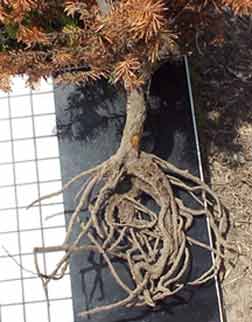Managing grubs in Christmas trees
A resource on managing grubs in Christmas trees.
Editor’s note: This article is from the archives of the MSU Crop Advisory Team Alerts. Check the label of any pesticide referenced to ensure your use is included.
Growers from around the state are reporting losses of young trees to grubs. The larvae of June beetles or European chafer will feed on the roots of Christmas trees killing many newly planted trees. Injury usually occurs during the first two growing seasons. To determine if your trees died from grubs, examine the roots of dead or dying seedlings or transplants. If it is damage from grubs, you will find little to no small feeder roots. With European chafer, we have seen some situations where grubs have fed on spruce tree roots causing small trees to die (about 75 percent of the trees in one field) and larger trees to fall over because they had no root system. Four grubs can kill a 2 to 3 foot tall tree. If you find grubs, you may want to take them to your local extension office or send them into Diagnostic Services to be identified. Here is a link to “Identifying Common White Grubs in Michigan” by Howard Russell, http://www.pestid.msu.edu/profiles/index.htm
June beetle
In May or June, the adult beetles emerge from the soil, feed on hardwood leaves near the field and mate. They return to the field to lay eggs in the soil. The newly hatched larvae burrow in the soil and feed on roots for two to five years. If you are finding grubs in a variety of sizes, you may want to treat the field now with Sevin ( carbaryl). Sometimes we find that populations may be synchronized to emerge every three years. If you have a big hatch (every three years) then make sure you are making an applicaion at those high years with imidacloprid (Admire) or thiamethoxam (Flagship) the end of May through June (adult flight through peak hatch). Rain or irrigation (a half to 1 inch) is needed to move the insecticide down to where the grubs are.
European chafer
European chafer may become more and more of a problem throughout the Lower Peninsula. European chafer has a one-year life cycle. They will be done feeding by the end of May. If you have European chafer, target your control for the newly hatched larvae in July (adult flight through peak hatch) with imidacloprid (Admire) or thiamethoxam (Flagship). Rain or irrigation (a half to 1inch) is needed to move the insecticide down to where the grubs are.



 Print
Print Email
Email


